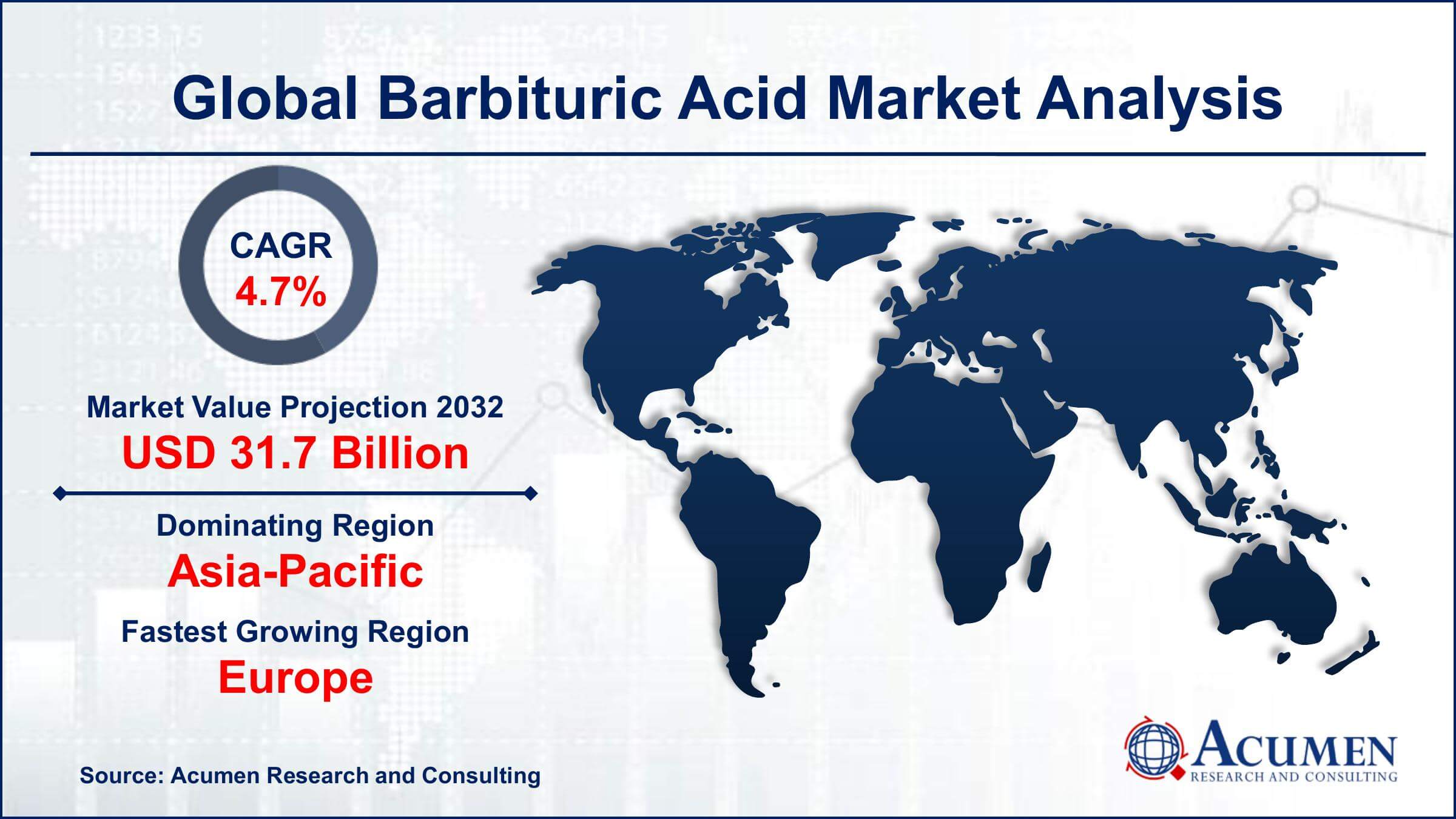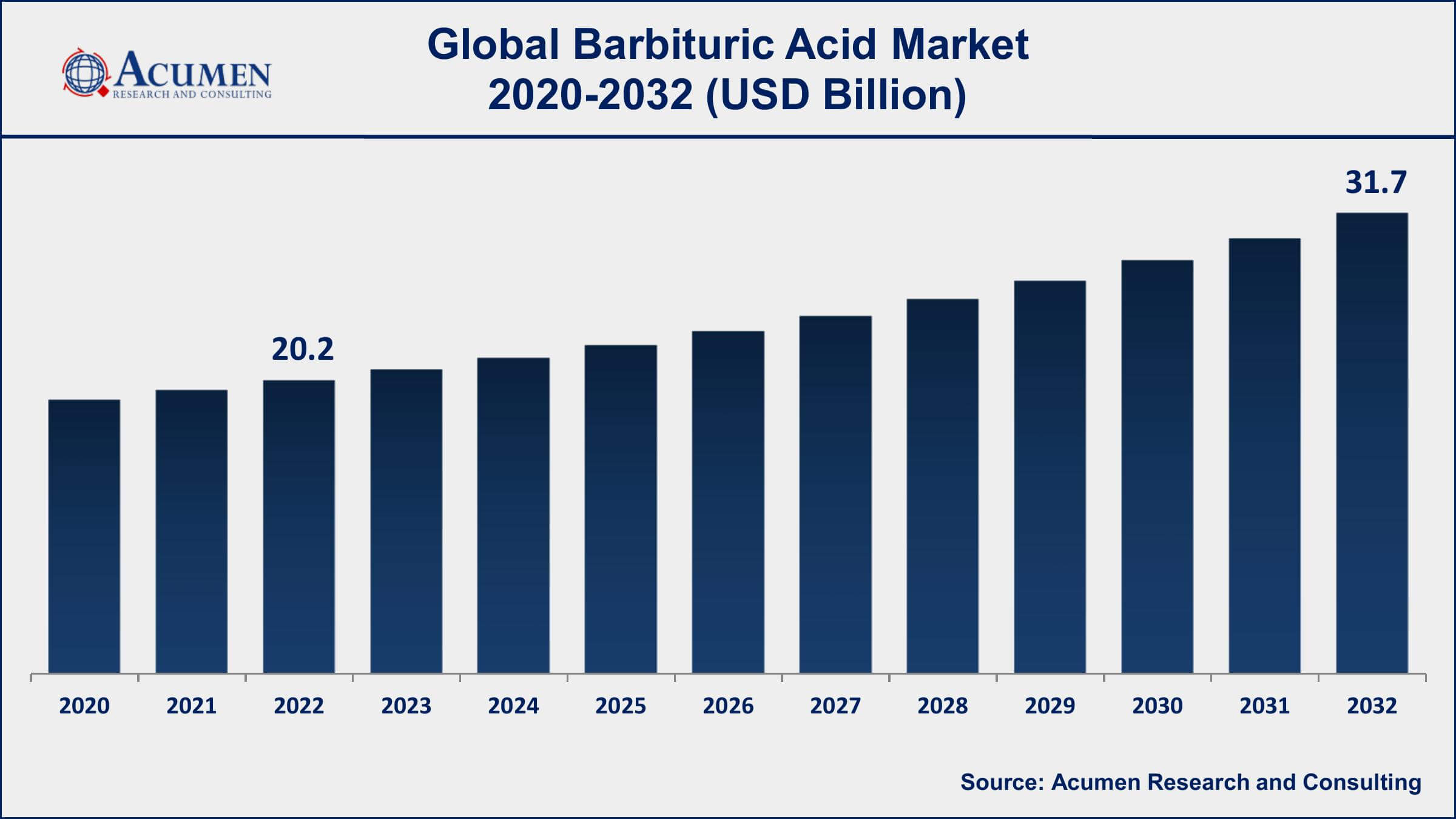Barbituric Acid Market Size - Global Industry, Share, Analysis, Trends and Forecast 2023 - 2032
Published :
Report ID:
Pages :
Format :
Barbituric Acid Market Size - Global Industry, Share, Analysis, Trends and Forecast 2023 - 2032
Report Coverage
- Industry Dynamics
- Market Size and Forecast Data
- Segment Analysis
- Competitive Landscape
- Regional Analysis with a Niche Focus on Country-Level Data
- High Level Analysis - Porter's, PESTEL, Value Chain, etc.
- Company Profiles of Key Players
- Option to Customize the Report As Per Your Specific Need
Request Sample Report
The Global Barbituric Acid Market Size accounted for USD 20.2 Billion in 2022 and is projected to achieve a market size of USD 31.7 Billion by 2032 growing at a CAGR of 4.7% from 2023 to 2032.
Barbituric Acid Market Highlights
- Global barbituric acid market revenue is expected to increase by USD 31.7 Billion by 2032, with a 4.7% CAGR from 2023 to 2032
- Asia-Pacific region led with more than 42% of barbituric acid market share in 2022
- North America barbituric acid market growth will record a CAGR of around 5% from 2023 to 2032
- By grade, the pharmaceutical grade (99%) sub-segment generated around 70% share in 2022
- By applications, the nutritional supplement segment is predicted to grow at a remarkable CAGR between 2023 and 2032
- Increasing usage of barbituric acid derivatives in pharmaceuticals, agrochemicals, and dyes, drives the barbituric acid market value

Barbituric acid is an organic compound that serves as the backbone of barbiturate drugs, which are central nervous system depressants used as sedatives, hypnotics, and anesthetics. The acid was first discovered in 1864 by the German chemist Adolf von Baeyer, and it is synthesized by the reaction of urea and malonic acid. Its derivatives, barbiturates, have been widely used in medicine for almost a century. However, due to their adverse effects, such as addiction, dependence, and overdose, their usage has declined over the years, and many countries have imposed strict regulations on their use and distribution.
Despite the decline in the usage of barbiturates, the market for barbituric acid continues to grow, driven by its applications in the synthesis of other compounds such as pharmaceuticals, agrochemicals, and dyes. Barbituric acid derivatives are also used as ligands in coordination chemistry and as building blocks for the synthesis of natural products and materials. Furthermore, the increasing demand for customized and specialty chemicals in various industries, including pharmaceuticals and agrochemicals, is expected to boost the market growth of barbituric acid in the coming years. In addition, the rising interest in research on new barbituric acid derivatives with potential therapeutic applications is expected to create new opportunities for the market in the near future.

Global Barbituric Acid Market Trends
Market Drivers
- Growing demand for customized and specialty chemicals in various industries
- Increasing usage of barbituric acid derivatives in pharmaceuticals, agrochemicals, and dyes
- Rising interest in research on new barbituric acid derivatives with potential therapeutic applications
- Growing demand for barbituric acid derivatives as ligands in coordination chemistry and building blocks for the synthesis of natural products and materials
Market Restraints
- Strict regulations on the use and distribution of barbiturate drugs
- Adverse effects of barbiturate drugs such as addiction, dependence, and overdose
Market Opportunities
- Development of new barbituric acid derivatives with improved therapeutic properties and fewer side effects
- Increasing investment in research and development of specialty chemicals
Barbituric Acid Market Report Coverage
| Market | Barbituric Acid Market |
| Barbituric Acid Market Size 2022 | USD 20.2 Billion |
| Barbituric Acid Market Forecast 2032 | USD 31.7 Billion |
| Barbituric Acid Market CAGR During 2023 - 2032 | 4.7% |
| Barbituric Acid Market Analysis Period | 2020 - 2032 |
| Barbituric Acid Market Base Year | 2022 |
| Barbituric Acid Market Forecast Data | 2023 - 2032 |
| Segments Covered | By Grade, By Application, By End-Use Industry, And By Geography |
| Regional Scope | North America, Europe, Asia Pacific, Latin America, and Middle East & Africa |
| Key Companies Profiled | Sanofi-Aventis, Bayer AG, Pfizer Inc., Novartis International AG, Roche Holding AG, Merck & Co., Inc., Bristol-Myers Squibb Company, Teva Pharmaceutical Industries Ltd., AbbVie Inc., and GlaxoSmithKline plc. |
| Report Coverage |
Market Trends, Drivers, Restraints, Competitive Analysis, Player Profiling, Covid-19 Analysis, Regulation Analysis |
Barbituric acid also known as 6-hydroxyuracil or malonylurea is an organic compound. Barbituric is an odorless powder soluble and readily mixes in water. It is a pyrimidine heterocyclic skeleton with chemical formula is C4H4N2O3, a molar mass is 128.09 g/mol and a melting point of 245 °C. The appearance of barbituric acid is found in white crystals. The parent compound of barbiturate drugs is barbituric acid, but pharmacologically barbituric acids are not active.
High utilization in the pharmaceutical industry is expected to boost the growth of this market in the future. Barbituric acid forms several barbiturate drugs that behave as central nervous system depressants. Some the medicines like Barbital (Veronal) and phenobarbital use barbiturate drugs. However, the overdose of barbituric acid can cause health hazards such as respiratory problems.
Barbituric Acid Market Segmentation
The global barbituric acid market segmentation is based on grade, application, end-use industry, and geography.
Barbituric Acid Market By Grade
- Pharmaceutical Grade (99%)
- Industrial Grade (98%)
According to the barbituric acid industry analysis, the pharmaceutical grade (99%) segment accounted for the largest market share in 2022. Pharmaceutical grade barbituric acid is used as a key raw material for the production of barbiturate drugs, which are widely used in medicine as sedatives, hypnotics, and anesthetics. Barbiturate drugs are prescribed for various medical conditions, such as anxiety, insomnia, and seizure disorders. The increasing demand for customized and specialty chemicals in the pharmaceutical industry is expected to fuel the market growth of pharmaceutical grade barbituric acid in the coming years. Furthermore, the rising interest in research on new barbituric acid derivatives with potential therapeutic applications is expected to create new opportunities for the market in the near future.
Barbituric Acid Market By Application
- Pharmaceutical Intermediate
- Nutritional Supplement
- Dye Intermediate
In terms of applications, the nutritional supplement segment is expected to witness significant growth in the coming years. Barbiturate drugs, which are derived from barbituric acid, have a sedative effect and are not typically used in nutritional supplements. Nutritional supplements are designed to support and improve overall health and wellness, and their ingredients are carefully selected for their safety and efficacy. The nutritional supplement segment is still in its infancy and is currently a small fraction of the overall market. However, the growing interest in natural and plant-based supplements, coupled with the increasing demand for antioxidant supplements, is expected to drive the growth of this segment in the coming years. The potential health benefits of barbituric acid derivatives, such as their antioxidant and anti-inflammatory properties, make them attractive as potential dietary supplements.
Barbituric Acid Market By End-Use Industry
- Plastics
- Textiles
- Pharmaceutical
- Polymers
- Others
According to the barbituric acid market forecast, the pharmaceutical segment is expected to witness significant growth in the coming years. Barbiturate drugs are a class of sedative-hypnotic drugs that have been used for a variety of medical purposes, including the treatment of anxiety, insomnia, and seizure disorders. While the usage of barbiturate drugs has declined over the years due to their adverse effects, the pharmaceutical industry continues to rely on barbituric acid derivatives in the production of other drugs and research chemicals. The increasing demand for customized and specialty chemicals in the pharmaceutical industry is expected to drive the market growth of barbituric acid derivatives in the coming years. The rising interest in research on new barbituric acid derivatives with potential therapeutic applications is also expected to create new opportunities for the pharmaceutical segment.
Barbituric Acid Market Regional Outlook
North America
- U.S.
- Canada
Europe
- U.K.
- Germany
- France
- Spain
- Rest of Europe
Asia-Pacific
- India
- Japan
- China
- Australia
- South Korea
- Rest of Asia-Pacific
Latin America
- Brazil
- Mexico
- Rest of Latin America
The Middle East & Africa
- South Africa
- GCC Countries
- Rest of the Middle East & Africa (ME&A)

Barbituric Acid Market Regional Analysis
The Asia-Pacific region is currently dominating the global barbituric acid market, driven by the significant growth in the pharmaceutical and agrochemical industries in the region. The increasing demand for barbituric acid derivatives as raw materials for the production of pharmaceuticals and agrochemicals, as well as the availability of raw materials for barbituric acid synthesis in the region, have contributed to the growth of the market in Asia-Pacific. Moreover, the region has a large and growing population, which has resulted in an increased demand for medicines, food, and agricultural products, driving the demand for barbituric acid derivatives in the pharmaceutical and agrochemical industries. Additionally, the increasing investment in research and development activities in the pharmaceutical and biotechnology sectors in countries such as China and India has further contributed to the growth of the market in the region. Furthermore, the presence of a large number of key market players in the Asia-Pacific region, along with the availability of cheap labor and favorable government regulations, has also contributed to the growth of the market in the region.
Barbituric Acid Market Player
Some of the top barbituric acid market companies offered in the professional report include Sanofi-Aventis, Bayer AG, Pfizer Inc., Novartis International AG, Roche Holding AG, Merck & Co., Inc., Bristol-Myers Squibb Company, Teva Pharmaceutical Industries Ltd., AbbVie Inc., and GlaxoSmithKline plc.
Frequently Asked Questions
What was the market size of the global barbituric acid in 2022?
The market size of barbituric acid was USD 20.2 Billion in 2022.
What is the CAGR of the global barbituric acid market from 2023 to 2032?
The CAGR of barbituric acid is 4.7% during the analysis period of 2023 to 2032.
Which are the key players in the barbituric acid market?
The key players operating in the global market are including Sanofi-Aventis, Bayer AG, Pfizer Inc., Novartis International AG, Roche Holding AG, Merck & Co., Inc., Bristol-Myers Squibb Company, Teva Pharmaceutical Industries Ltd., AbbVie Inc., and GlaxoSmithKline plc.
Which region dominated the global barbituric acid market share?
Asia-Pacific held the dominating position in barbituric acid industry during the analysis period of 2023 to 2032.
Which region registered fastest CAGR from 2023 to 2032?
North America region exhibited fastest growing CAGR for market of barbituric acid during the analysis period of 2023 to 2032.
What are the current trends and dynamics in the global barbituric acid industry?
The current trends and dynamics in the barbituric acid industry include growing demand for customized and specialty chemicals in various industries, and increasing usage of barbituric acid derivatives in pharmaceuticals, agrochemicals, and dyes.
Which application held the maximum share in 2022?
The pharmaceutical intermediate application held the maximum share of the barbituric acid industry.



